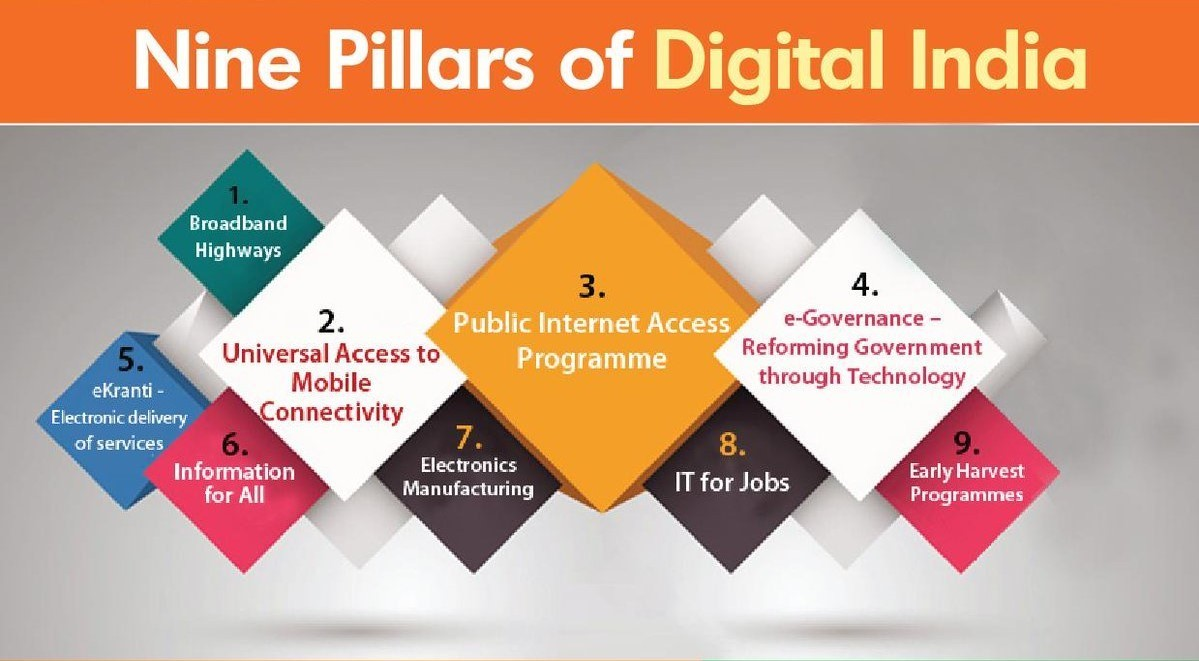Governance
Nine Years of Digital India Initiative
- 04 Jul 2024
- 8 min read
For Prelims: Digital India initiatives, living standards, fostering transparency. E-governance, economic growth, Common Service Centres, IT skills, Digital Literacy, IT Act of 2000,
For Mains: Challenges, Initiatives of Digital India Initiatives.
Why in News?
Recently, the Prime Minister emphasised the substantial impact of Digital India initiatives, marking its successful nine-year journey. He characterised Digital India as a symbol of national empowerment, elevating living standards and fostering transparency.
What is the Digital India Initiative?
- About:
- Digital India, was launched on 1st July 2015 by the Indian Government.
- This program builds upon earlier e-governance efforts that began in the mid-1990s but lacked cohesion and interactivity.
- Objective:
- Narrowing the Digital Divide: The initiative works to lessen the disparity between tech-savvy individuals and those with limited digital access.
- Promoting Digital Participation: It strives to ensure equitable access to digital technology benefits for all citizens, encompassing areas like education, healthcare, and government services.
- Stimulating Economic Development: By tapping into technological advancements and innovative solutions, Digital India aims to drive economic growth across the country.
- Elevating Living Standards: The program seeks to enhance citizens' overall quality of life through the strategic application of technology in various aspects of daily living.
- Nine Pillars of Digital India Initiative:
- Broadband Highways: Focus on building extensive high-speed broadband networks nationwide to boost connectivity and digital empowerment.
- Universal Access to Mobile Connectivity: Extend mobile coverage to remote areas, enabling all citizens to engage with mobile services and participate in the digital economy.
- Public Internet Access Programme: Establish Common Service Centres in underserved areas to provide affordable internet access, addressing the digital divide and promoting digital literacy.
- E-Governance, Utilize Technology to Streamline Government Services: Improving accessibility, efficiency, and transparency while enhancing citizen engagement.
- E-Kranti: Platforms such as MyGov.in facilitate the electronic delivery of government services to citizens, prioritizing accessibility and operational efficiency.
- Information for All: Digitise government records for online accessibility and promote open data initiatives to fuel innovation and development.
- Electronics Manufacturing: Encourage local electronics manufacturing to reduce imports, create jobs, and support digital economic growth through manufacturing clusters and investment incentives.
- Information Technology (IT) for Jobs: Enhance youth IT skills to meet growing industry demands through programs like Digital Literacy Mission and Skill India, focusing on skill enhancement and IT sector employment.
- Early Harvest Programs: Include specific projects addressing immediate digital needs, such as online access to school certificates, digital attendance, and Wi-Fi in public spaces.
What are the Various Digital India Initiatives Taken for Digital India?
- Aadhaar: A biometric identification system that assigns unique 12-digit identity numbers to residents.
- BharatNet: A project aimed at providing high-speed broadband connectivity to villages, enabling digital services in rural areas.
- Startup India: An initiative to promote entrepreneurship and support startups through incentives, funding, and mentoring.
- e-NAM: An online trading platform that connects agricultural markets, facilitating efficient sale of produce.
- Digital Locker: A cloud-based platform for securely storing and accessing important documents digitally.
- BHIM UPI: A digital payment system that enables secure peer-to-peer transactions using smartphones.
- eSign Framework: Allows online signing of documents using digital signatures.
- MyGov: A citizen engagement platform that facilitates participation in governance and policy discussions.
- e-Hospital: Digitised hospital services, including online registration and access to health records.
- SWAYAM
- UMANG App
- Smart Cities Mission
- Digital India Act (DIA), 2023: The proposed act aims to replace the outdated IT Act of 2000, adapting to India's growing internet user base, technological advancements, and new digital challenges. The DIA provides guidelines for responsible adoption of emerging technologies like AI and blockchain, encouraging innovation while maintaining ethical standards.
What are the Challenges and Way Forward Concerning Digital India?
| Challenges | Way Forward |
|
|
|
|
|
|
|
|
|
|
|
Drishti Mains Questions: Examine the Digital India initiatives, including the challenges they face and the corresponding measures required to address these challenges effectively. |
UPSC Civil Services Examination Previous Year Question (PYQ)
Prelims
Q. Consider the following: (2022)
- Aarogya Setu
- CoWIN
- DigiLocker
- DIKSHA
Which of the above are built on top of open-source digital platforms?
(a) 1 and 2 only
(b) 2, 3 and 4 only
(c) 1, 3 and 4 only
(d) 1, 2, 3 and 4
Ans: (d)
Mains
Q. “The emergence ofthe Fourth Industrial Revolution (Digital Revolution) hasinitiated e-Governance as an integral part of government”. Discuss. (2020)





